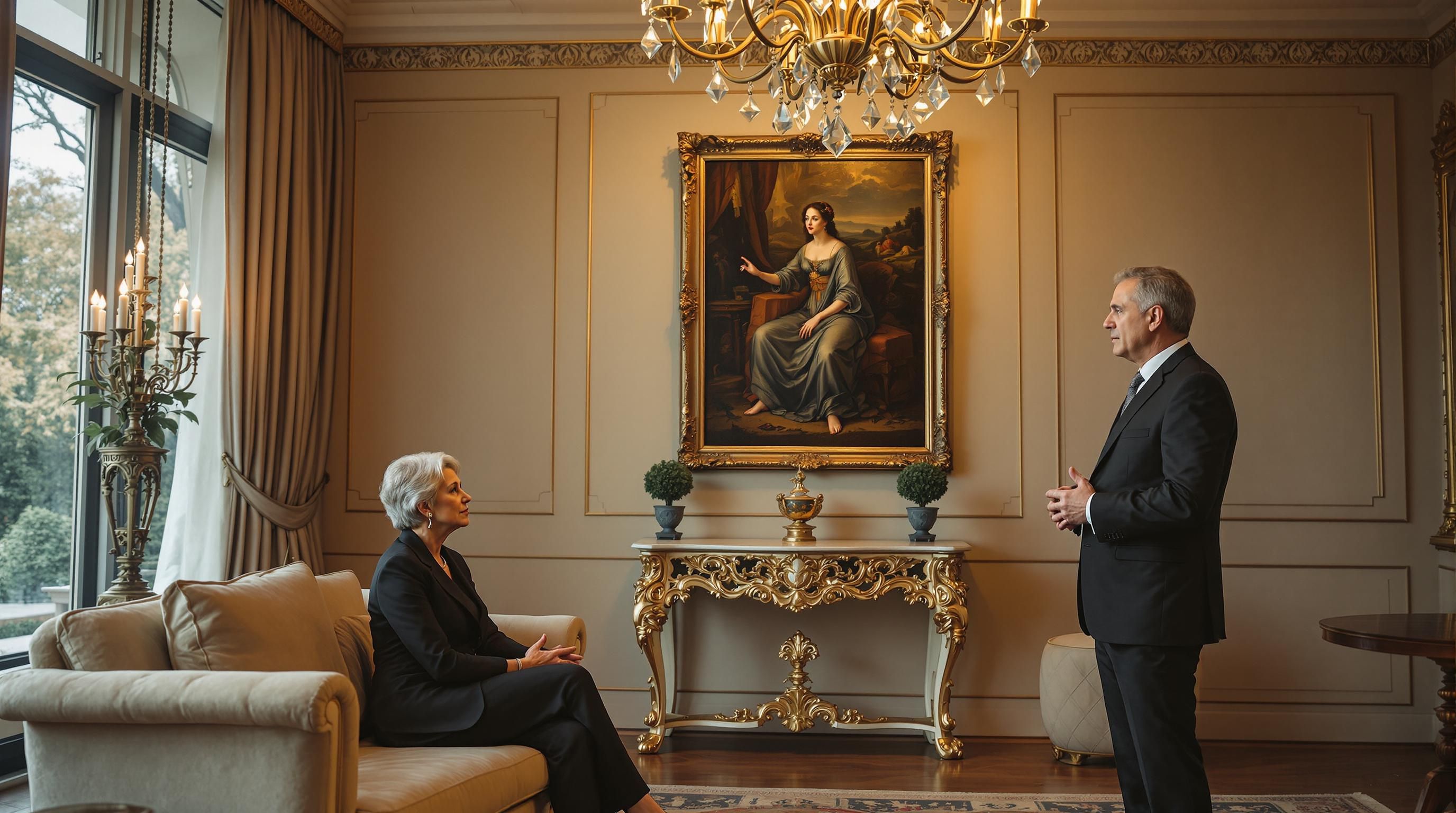Introduction to Art Appraisal
Art appraisers play a vital role in the art market ecosystem, providing objective valuations that inform insurance coverage, tax calculations, estate planning, donations, and sales decisions. But what exactly does an art appraiser do, and why is their expertise so valuable?
In this comprehensive guide, we’ll explore the multifaceted role of professional art appraisers, examining their methodologies, qualifications, and the various scenarios in which their services become essential. Whether you’re an art collector, investor, or simply curious about the process, understanding art appraisal can help you navigate the complex landscape of art valuation with confidence.
Art Appraisal at a Glance
What Is an Art Appraiser?
An art appraiser is a specialized professional who evaluates and determines the monetary value of artworks, antiques, and other cultural objects. Unlike art authentication experts who focus primarily on verifying the authenticity of a piece, appraisers concentrate on establishing fair market value, replacement value, or other relevant financial assessments depending on the appraisal’s purpose.
Art appraisers possess a combination of art historical knowledge, market expertise, and analytical skills that allow them to evaluate artworks methodically and objectively. According to CareerExplorer, they must understand not only the technical and aesthetic aspects of art but also the economic factors that influence its value in various contexts.
Core Responsibilities of Art Appraisers
Conducting Thorough Artwork Examinations
The appraisal process begins with a detailed physical examination of the artwork. Appraisers carefully assess:
- Medium and materials used
- Dimensions and scale
- Condition and conservation status
- Signature, date, and other markings
- Framing or mounting (when applicable)
- Technical execution and artistic quality
This hands-on evaluation forms the foundation for an accurate appraisal. As noted by David Barnett Gallery, appraisers pay particular attention to condition issues that might affect value, such as tears, discoloration, flaking paint, or previous restoration work.
Researching Provenance and History
Provenance—the documented history of an artwork’s ownership—significantly impacts valuation. Art appraisers research:
- Chain of ownership from creation to present
- Exhibition history
- Literature references and catalog inclusions
- Certificates of authenticity
- Prior sales records and auction results
According to TASA, establishing strong provenance can substantially increase an artwork’s value by confirming its authenticity and potentially uncovering significant historical connections.
Conducting Market Analysis and Comparative Research
Art appraisers don’t operate in isolation—they constantly monitor the art market to understand current trends and valuations. Their research includes:
- Analyzing comparable sales data
- Reviewing auction records
- Tracking gallery pricing
- Assessing market demand for similar works
- Evaluating the artist’s market position
As explained by Sparks Gallery, this involves consulting auction records, private sales data, and current market offerings to find comparable objects to the piece being appraised.
Determining Appropriate Value Types
Depending on the appraisal’s purpose, art appraisers may determine different types of values:
- Fair Market Value: The price at which property would change hands between a willing buyer and seller (used for tax purposes, donations, and estate planning)
- Replacement Value: The cost to replace an item with one of similar quality and utility (used for insurance purposes)
- Liquidation Value: The amount expected if the item must be sold quickly (used in bankruptcy or forced sales)
According to IMA Select, clearly understanding the appraisal’s purpose is essential, as it determines which valuation approach is most appropriate.
Preparing Detailed Appraisal Reports
The culmination of an appraiser’s work is a comprehensive written report that documents:
- Complete artwork description and condition assessment
- Provenance and exhibition history
- Comparative market analysis
- Value conclusion with supporting evidence
- Photographs and reference materials
- Statement of appraisal purpose and methodology
- Appraiser’s qualifications and credentials
These reports serve as authoritative documents for insurance companies, tax authorities, courts, and other entities that require professional art valuations.
When Do You Need an Art Appraiser?
Insurance Coverage and Claims
One of the most common reasons for art appraisal is to obtain appropriate insurance coverage. Insurance companies require professional appraisals to:
- Establish proper coverage amounts
- Document condition before any damage occurs
- Support claims if loss or damage happens
- Update policies as values change over time
According to MOMAA, regular reappraisals are recommended as art market values can fluctuate significantly over time.
Tax Purposes: Donations, Estates, and Gifting
The IRS requires qualified appraisals for art-related tax matters, including:
- Charitable donations of artwork valued over $5,000
- Estate tax returns involving art collections
- Gift tax calculations when art changes hands
- Casualty and theft loss deductions
Professional appraisers familiar with IRS requirements can provide legally compliant valuations that withstand tax authority scrutiny.
Buying and Selling Decisions
Before making significant art transactions, both buyers and sellers benefit from independent appraisals to:
- Verify fair asking prices
- Support negotiation positions
- Understand investment potential
- Make informed purchasing decisions
The Marshall Gallery emphasizes that appraisals can help both parties ensure transactions occur at prices aligned with current market realities.
Divorce and Asset Division
During divorce proceedings, equitable distribution of art assets requires:
- Neutral third-party valuations
- Documentation of acquisition dates
- Clear ownership records
- Current market valuations
Courts rely on professional appraisals to ensure fair division of art collections between divorcing parties.
Museum Donations and Loans
When artworks move between private collections and public institutions:
- Donations require established values for tax purposes
- Loans need insurance valuations
- Institutions may require condition reports
- Long-term loans may need periodic revaluation
Professional appraisals facilitate these transactions by providing credible, well-documented valuations acceptable to all parties involved.

Art Appraisal Methodology
The Three Approaches to Value
Art appraisers typically consider three fundamental approaches when determining value:
1. Sales Comparison Approach
This method identifies recently sold comparable artworks to establish value baselines. Appraisers consider:
- Works by the same artist with similar characteristics
- Pieces from the same period, style, or movement
- Comparable medium, size, and subject matter
- Recent sales in similar market conditions
According to discussions on Reddit, for emerging artists without extensive sales history, appraisers often analyze comparable sales from artists with similar styles, experience levels, and audience reach.
2. Cost Approach
Sometimes relevant for contemporary art, this approach considers:
- Cost of materials used
- Artist’s time invested
- Gallery markup and representation costs
- Production expenses for sculptures or installations
- Restoration or conservation costs
This method may be particularly useful for insurance replacement valuations or for works by living artists with limited secondary market history.
3. Income Approach
For art with income-generating potential, appraisers may consider:
- Potential licensing revenue
- Exhibition fees
- Reproduction rights value
- Investment return potential based on historical performance
- Projected value appreciation based on artist’s career trajectory
This approach is less common but may apply to commercially valuable works or collections managed as investment assets.
Factoring in Condition Assessment
An artwork’s physical condition significantly impacts its value. Appraisers meticulously document:
- Structural integrity issues
- Surface damage or alterations
- Previous restoration or conservation work
- Environmental damage (fading, foxing, etc.)
- Frame condition (for framed works)
Professional appraisers may use specialized equipment like UV lights, magnifiers, and other diagnostic tools to detect condition issues not visible to the naked eye.
Evaluating Authenticity and Attribution
While not authentication specialists per se, appraisers must consider authenticity factors:
- Signature verification
- Stylistic consistency with the artist’s known works
- Appropriate materials and techniques for the period
- Documentation and certificates
- Technical analysis results (when available)
Art Business explains that appraisers help us understand how the art world works, and in doing so, they make the art world make sense for everyone involved.
Market Context and Timing Considerations
Art values don’t exist in a vacuum. Appraisers analyze:
- Current market conditions for the specific category
- Artist’s recent sales performance and career stage
- Economic factors affecting art markets generally
- Collecting trends and shifting tastes
- Regional market variations
These contextual factors help ensure valuations reflect current market realities rather than outdated or isolated data points.
Qualifications and Credentials of Professional Art Appraisers
Educational Background
Most professional art appraisers have formal education in:
- Art history or fine arts
- Business, economics, or finance
- Museum studies or conservation
- Specialized appraisal coursework
According to Career Kaplan, art appraisers need in-depth knowledge of art history, art movements, artists, and market dynamics to perform their role effectively.
Professional Accreditation
Several organizations provide accreditation for art appraisers:
- Appraisers Association of America (AAA): Offers the Accredited Member (AM) and Certified Member (CM) designations
- American Society of Appraisers (ASA): Provides Personal Property Appraiser certification with specialization in Fine Art
- International Society of Appraisers (ISA): Offers Certified Appraiser of Personal Property (CAPP) designation
- Uniform Standards of Professional Appraisal Practice (USPAP): Provides essential standards training
These credentials typically require combination of education, experience, testing, and ongoing professional development.

Specialized Expertise
Many appraisers develop expertise in particular areas:
- Specific time periods (Renaissance, Modernism, Contemporary)
- Art movements (Impressionism, Cubism, Abstract Expressionism)
- Geographic regions (American, European, Asian)
- Media types (paintings, sculptures, prints, photography)
- Emerging markets and contemporary trends
This specialization allows for more nuanced and accurate valuations within their areas of expertise.
Ethical Requirements
Professional appraisers adhere to strict ethical standards, including:
- Avoiding conflicts of interest
- Maintaining confidentiality
- Providing objective, unbiased valuations
- Disclosing methodology and limitations
- Ongoing professional education
- Transparency regarding fees and services
These ethical guidelines ensure appraisers serve their clients’ interests while maintaining professional integrity.
Art Appraisal Fee Structures
Typical fee ranges for professional art appraisal services
</tbody>
</table>
Art Appraisal vs. Art Authentication
Primary Focus
Art Appraisal:
- Determines monetary value
- Considers market factors and comparable sales
- Results in a specific valuation figure
- Addresses economic questions
Art Authentication:
- Verifies genuine creation by the attributed artist
- Examines technical and stylistic evidence
- Results in an authenticity determination
- Addresses art historical questions
According to IMA Select, appraisals focus on determining monetary value for insurance purposes, while authentication establishes whether a piece is genuine.
Methodological Differences
Art Appraisal:
- Relies heavily on market research and comparables
- Considers condition as it affects value
- May use different valuation approaches based on purpose
- Requires regular updates as markets change
Art Authentication:
- Employs technical analysis (pigment testing, radiography, etc.)
- Conducts provenance research to establish history
- Studies stylistic elements for consistency
- Often involves connoisseurship and scholarly opinion
Professional Qualifications
Art Appraisers:
- Trained in valuation methodology
- Knowledge of art markets and economics
- Often certified by appraisal organizations
- May specialize in certain periods or media
Authentication Experts:
- Deep knowledge of specific artists or periods
- Often have art history or conservation backgrounds
- May include scientific researchers
- Sometimes affiliated with artist foundations or committees
When You Need Both Services
In some situations, both appraisal and authentication are necessary:
- High-value acquisitions
- Contested ownership situations
- Insurance claims involving questionable works
- Estate valuations of significant collections
- Donations to museums or institutions
In these cases, authentication typically precedes appraisal, as genuine works command different values than copies or misattributions.
Art Appraisal Preparation Checklist
Items to prepare before hiring an art appraiser
- Gather all available documentation on the artwork
- Collect purchase receipts and previous appraisals
- Photograph artwork from multiple angles
- Document any known history of the piece
- Research the artist's market performance
- Prepare a list of questions for the appraiser
- Ensure the artwork is accessible for examination
- Clean the artwork's surface gently (if appropriate)
How to Select the Right Art Appraiser
Verify Credentials and Specialization
Before hiring an appraiser:
- Check for membership in professional organizations (AAA, ASA, ISA)
- Confirm USPAP compliance and current certification
- Verify specialized expertise in your artwork’s category
- Review educational background and training
- Ask about years of experience in the field
An appraiser’s expertise should align with the type, period, and style of artwork you need evaluated.
Consider the Appraisal’s Purpose
Different purposes may require different appraiser qualifications:
- Insurance appraisals: Select appraisers familiar with insurance industry requirements
- Tax-related appraisals: Choose appraisers who understand IRS regulations and can produce IRS-compliant reports
- Donation appraisals: Work with appraisers experienced in charitable contribution valuations
- Estate appraisals: Seek professionals with estate and probate experience
- Market value appraisals: Consider appraisers with strong auction or gallery connections
The appraisal’s intended use should guide your selection process.
Review Sample Reports and References
Quality indicators include:
- Comprehensive, well-organized sample reports
- Clear methodology explanations
- Thorough market analysis sections
- Professional presentation and documentation
- Strong client testimonials and references
- Reputation among art professionals
Request sample reports (with confidential information redacted) to assess quality and thoroughness.
Discuss Fees and Timeframes
Professional appraisers should provide:
- Clear fee structures (hourly rates or flat fees)
- Written estimates before beginning work
- Reasonable timeframes for completion
- Explanation of what the fee includes
- Any additional costs for research or travel
Beware of appraisers who base fees on a percentage of the appraised value, as this creates potential conflicts of interest.
Evaluate Independence and Objectivity
Ensure your appraiser:
- Has no financial interest in your artwork
- Doesn’t offer to buy items they appraise
- Provides objective valuations without bias
- Works independently from dealers or auction houses
- Discloses any potential conflicts of interest
Independent appraisers provide more credible valuations than those with potential conflicts.
The Future of Art Appraisal
Technological Impacts
Several technologies are transforming art appraisal:
- Blockchain for provenance tracking: Creating immutable ownership records
- Artificial intelligence for comparables: Enhancing market research capabilities
- Digital condition reporting tools: Improving documentation precision
- Virtual examination technology: Enabling remote appraisals
- Big data analytics: Identifying market trends and patterns
These innovations may increase efficiency and accuracy while potentially reducing costs for certain types of appraisals.
Regulatory Changes
The appraisal profession faces evolving regulatory oversight:
- Increased IRS scrutiny of high-value art donations
- More stringent requirements for qualified appraisers
- Enhanced anti-money laundering protocols affecting art transactions
- International standardization of appraisal methodologies
- Greater emphasis on appraiser independence
These regulatory trends suggest continuing professionalization and standardization within the field.
Market Globalization
Global factors increasingly influence art valuation:
- Expanding international collector bases
- Online marketplaces connecting worldwide buyers and sellers
- Emerging art markets in Asia and other regions
- Cross-border cultural property regulations
- International tax considerations for collections
Modern appraisers must consider global market dynamics even when valuing regionally specific artworks.
Specialized Expertise Development
The profession is seeing increased specialization in:
- Digital and NFT art valuation
- Emerging market expertise
- Cross-disciplinary approaches (art and finance)
- Cultural heritage valuation
- Scientific analysis integration
This specialization reflects the growing complexity of both art markets and the appraisal profession itself.
Common Questions About Art Appraisers
How much does an art appraisal cost?
Art appraisal costs vary widely based on several factors:
- The number of items being appraised
- The complexity of the artwork(s)
- The appraisal’s purpose (insurance, tax, donation, etc.)
- The appraiser’s experience and credentials
- The depth of research required
Typical fees range from $150-$300 per hour, with single-item appraisals often costing $250-$500. More complex collections may be charged at flat rates ranging from $1,000-$5,000 or more, depending on size and complexity. Some appraisers may require a minimum fee regardless of the project scope.
For tax-related appraisals (especially for high-value items), expect to pay more due to the additional documentation requirements and potential liability for the appraiser.
How do I become an art appraiser?
Becoming an art appraiser typically involves several steps:
Educational Foundation: Obtain a degree in art history, fine arts, or a related field. Many appraisers have advanced degrees.
Practical Experience: Work in galleries, museums, auction houses, or with established appraisers to gain practical knowledge of art markets and valuation.
Professional Training: Complete specialized appraisal courses through organizations like the Appraisers Association of America (AAA), American Society of Appraisers (ASA), or International Society of Appraisers (ISA).
USPAP Compliance: Take the Uniform Standards of Professional Appraisal Practice course, which is required for most professional appraisers.
Certification/Accreditation: Apply for membership and accreditation through a professional appraisal organization, which typically requires submitting sample appraisals, passing exams, and demonstrating experience.
Continuing Education: Maintain credentials through ongoing professional development and regular recertification.
Specialization: Develop expertise in specific art periods, movements, media, or geographic regions.
The process typically takes several years of dedicated study and practice before achieving professional recognition.
What's the difference between an art appraisal and an auction estimate?
Art appraisals and auction estimates serve different purposes and are created through different processes:
Art Appraisals:
- Are formal, comprehensive documents created for specific purposes (insurance, tax, estate planning)
- Follow strict methodology and professional standards (like USPAP)
- Include extensive research, documentation, and analysis
- Represent the appraiser’s opinion of value in a specific context (fair market value, replacement value, etc.)
- Are legally binding documents that can be used for official purposes
- Include detailed descriptions, condition reports, and valuation reasoning
- Are created by certified appraisers with professional liability
Auction Estimates:
- Are informal projections of potential selling ranges at auction
- Represent the auction house’s educated guess about bidding outcomes
- Are typically provided as ranges (e.g., $5,000-$7,000)
- Are often free services provided by auction houses
- May be influenced by the auction house’s desire to secure consignments
- Don’t follow standardized methodology or require specific credentials
- Cannot typically be used for insurance, tax, or legal purposes
- Primarily serve to guide sellers’ expectations and attract buyers
While both involve valuing artwork, they serve different purposes and should not be considered interchangeable.
How long does an art appraisal remain valid?
Art appraisals have limited shelf lives due to market fluctuations and changing conditions:
Insurance appraisals: Generally valid for 3-5 years, though many insurance companies recommend updates every 2-3 years for high-value items.
Tax appraisals: The IRS requires appraisals to be conducted no earlier than 60 days before the date of contribution and no later than the due date for the tax return.
Estate appraisals: Must reflect value at the date of death or alternate valuation date (six months after death).
Donation appraisals: Must be made not earlier than 60 days prior to the donation date.
Several factors can necessitate more frequent reappraisals:
- Significant market fluctuations for the artist or category
- Changes in the artwork’s condition
- Major exhibitions or publications featuring the artist
- Artist’s death or other career-changing events
- Changes in critical reception or scholarly opinion
For valuable collections, establishing a regular appraisal update schedule (every 2-3 years) is generally recommended.
Can I get art appraised for free?
While true professional art appraisals are rarely free, several options exist for obtaining informal valuations or estimates at no cost:
Auction house specialists: May provide free auction estimates (not formal appraisals) if they believe your item might be appropriate for their sales.
Gallery consultations: Some galleries offer informal valuations for works by artists they represent or specialize in.
Museum curators: Occasionally provide historical information about artworks, though many institutions prohibit staff from offering valuations.
Online valuation tools: Some websites offer automated estimates based on database information, though these lack personalized analysis.
Appraisal events: Some museums, antique shows, or community events host “valuation days” where appraisers provide quick, informal assessments.
Important limitations of free valuations:
- Lack the thoroughness of formal appraisals
- Cannot be used for insurance, tax, or legal purposes
- May be subject to conflicts of interest (e.g., dealers looking to purchase)
- Often focus on auction potential rather than other value types
- Don’t include comprehensive documentation or research
For any official purpose or valuable artwork, a professional paid appraisal is necessary and well worth the investment.
What information should be included in an art appraisal report?
A professional art appraisal report should contain comprehensive information about the artwork and its valuation. Essential elements include:
Identification Information
- Artist’s name and biographical information
- Title of the work
- Date of creation
- Medium and materials
- Dimensions
- Signature locations and details
- Edition information (for prints or multiples)
Physical Description
- Detailed visual description
- Construction or technique
- Subject matter or composition
- Frame or mounting description (if relevant)
Condition Assessment
- Current condition with detailed notes
- Any damage, repairs, or conservation
- Stability issues or concerns
- Environmental exposure effects
Provenance Information
- Ownership history
- Exhibition history
- Literature references
- Certificates of authenticity
Valuation Details
- Type of value determined (fair market, replacement, etc.)
- Valuation amount with effective date
- Purpose of the appraisal
- Valuation approach and methodology
- Market analysis and comparable sales
- Limiting conditions and assumptions
Documentation
- Photographs of the artwork
- Signature and details images
- Comparable sales evidence
- Relevant market data
Appraiser Information
- Appraiser’s credentials and qualifications
- Professional organization memberships
- USPAP compliance statement
- Signed certification
- Confidentiality statements
The report should be clearly written, well-organized, and professionally presented, as it may be used for important financial, legal, or insurance decisions.
Conclusion: The Essential Role of Art Appraisers
Art appraisers serve as crucial intermediaries between artistic value and financial worth, applying specialized knowledge, methodical research, and professional standards to determine accurate valuations. Their work impacts numerous aspects of the art ecosystem:
- Providing confidence for collectors making significant investments
- Ensuring proper insurance protection for valuable collections
- Facilitating fair tax treatment for donations and estates
- Supporting proper asset division in complex situations
- Helping museums and institutions manage collections responsibly
- Contributing to market transparency and stability
As Art Business aptly notes, art appraisers help all of us understand how the art world works, making it more accessible and comprehensible for everyone involved.
Whether you’re a seasoned collector, new art buyer, legal professional, or institution administrator, understanding the role and value of professional art appraisers can help you navigate the complex intersection of art, finance, and law with greater confidence. When significant values or important decisions are at stake, the expertise of a qualified art appraiser becomes not just valuable but essential.
External Resources for Art Appraisal
Sparks Gallery: How Fine Art Appraisal Works
Comprehensive overview of the art appraisal process, explaining the different types of appraisals and when they're needed.
David Barnett Gallery: Fine Art Appraisal Process
Detailed explanation of appraisal methodology including the use of auction records, private sales data, and comparable works research.
The Marshall Gallery: Art Appraisal 101
Basic guide covering the factors appraisers consider when determining artwork value and how to prepare for an appraisal.
MOMAA: Art Appraisal Guide
Updated guide with seven key insights for accurate art valuations, discussing purpose, methodology, and best practices.
TASA: Professional Art Appraisal Article
Resource specifically for attorneys and clients explaining what to expect from a professional art appraisal and how to use it effectively.
Art Business: The Value of Art Appraisers
Discussion of the broader importance of art appraisers in maintaining market integrity and providing objective expertise.
IMA Select: Art Appraisals vs. Authentication
Clear explanation of the differences between art appraisal and authentication processes and when each service is appropriate.
Career Explorer: Art Appraiser Career Guide
Comprehensive guide to art appraisal as a career path, including education requirements and professional expectations.
Get a Professional Appraisal
Unsure about your item’s value? Our certified experts provide fast, written appraisals you can trust.
- Expert report with photos and comps
- Fast turnaround
- Fixed, upfront pricing
No obligation. Secure upload.
| Category | Price | Notes |
|---|---|---|
| Hourly Rate | $150-$300/hour | Common for smaller collections or single pieces |
| Flat Fee (Single Item) | $250-$500 | Simple appraisal of individual artwork |
| Collection Rate (Multiple Items) | $1,000-$5,000+ | Varies based on collection size and complexity |
| Percentage-Based Fee | 0.1% to 0.5% of total value | Sometimes used for high-value collections |
| Annual Retainer | $2,000-$10,000/year | For ongoing appraisal services and value updates |




